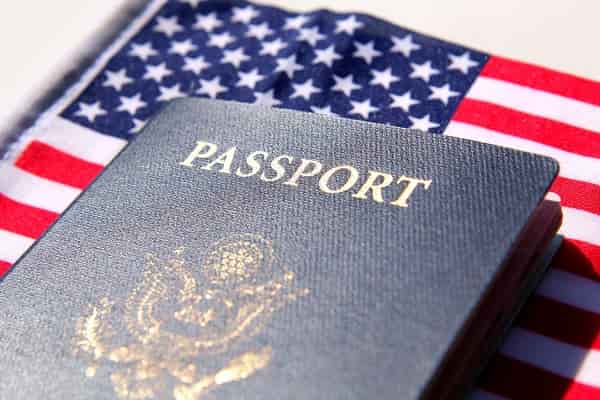
Green Card through Family Reunion
The most common form of immigration to the USA is via family reunification. Those who do not qualify for a Green Card through their job can also obtain permanent residency through marriage or by being related to a US American or Green Card holder.

Who will get a family-based Green Card?
Those who do not qualify for a job-based Green Card or did not have any luck in the Green Card Lottery can also obtain permanent residency by marrying or being related to a US American or another Green Card holder..

Obtaining a Green Card through a family member who is either a US citizen or a Green Card holder is one of the most common forms of immigration visa.
The purpose of this type of family reunion is to allow US citizens and Green Card holders to legally bring their foreign relatives to the US to be closer to them.
This Green Card category distinguishes whether the applicant is a US citizen or a Lawful Permanent Resident, i.e. a Green Card holder. In each of the two sub-categories there are different waiting periods and requirements to be met.
| Category | Relative | Sponsor | Waiting period | Green Card Quota / Year |
| IR-1 | Spouses | US citizen | no | unlimited |
| IR-2 | Unmarried children under 21 years of age | US citizen | no | unlimited |
| IR-3 / IH-3 | Children adopted outside the USA | US citizen | no | unlimited |
| IR-4 / IH-4 | Children to be adopted in the USA | US citizen | no | unlimited |
| IR-5 | Parents | US citizen | no | unlimited |
| F-1 | Unmarried children over 21 years and their minor children | US citizen | 7 - 21 years | approx. 23.400 |
| F-2A | Spouses and unmarried children under 21 years of age | Green Card holder | 2 years | minimum 87.900 |
| F-2B | Unmarried children over 21 years | Green Card holder | 7-21 years | minimum 26.200 |
| F-3 | Married children, their spouses and their minor children | US citizen | 12 - 23 years | approx. 23.400 |
| F-4 | Siblings | US citizen | 14 - 23 years | approx. 65.000 |
Applicants from Europe can generally orientate themselves towards the lower limit of the time periods mentioned. The longer waiting periods apply primarily to China (mainland), India, Mexico and the Philippines.
What are family-sponsored preference categories?
As an enormous number of family-based applications are received each year, applications from certain family members are given preference.
For example, spouses, unmarried children under the age of 21 and parents of a US citizen are considered immediate relatives and are given preference. There is no numerical limit or waiting period for these groups. This means that a Green Card is issued immediately after each successfully reviewed application, without any country-specific limitations.
For all other groups, only a certain quota of Green Cards is available per tax year. If more applications are received than the available capacity, these applications do not expire but are put on a waiting list.
The different applicant groups are divided into so-called preference categories of family immigration, depending on their family relations and the applicant. Each preference category results in certain waiting periods, which are publicly available in the monthly Visa Bulletin.
Green Card through relationship with US citizens
Relatives of US citizens are given preferential treatment. Here again, a distinction is made between Immediate Relatives and Other Close Family Members.
Immediate relatives have priority over all other relatives and are not subject to any numerical limitations. They may immigrate without a waiting period. This includes the following groups of persons:
- Spouses of US citizens
- Children under 21 and unmarried
- Parents of the US citizen
Non-immediate relatives of US citizens have a lower status than close relatives and are therefore subject to certain waiting periods. These groups of people include the following:
- Children over the age of 21 and/or married
- Siblings of the US citizen
Green Card for spouses of US citizens
This Green Card category is called IR-1 category.
Spouses of US citizens are eligible for a Green Card if the following conditions are met:
- The marriage was legally binding at the time of marriage.
- The marriage is still legally binding.
- The marriage was not arranged for the purpose of immigration to the USA.
In the case of sub-category IR-1, it should also be noted that marriages that were entered into less than two years prior to the date of application for the Green Card are issued conditionally. Two years after the Green Card has been issued, the marriage will be re-examined and the immigrant visa will be issued on a permanent basis if appropriate.
Background: It is estimated that approximately 8% of all IR-1 applicants have married only to obtain a residence permit in the USA. Since this is not in line with the idea of family reunion, the visa is only issued "on trial" for the time being.

Spouses of US citizens can receive an IR-1 Green Card!
K1 Visa for fiancées
In order for a US citizen to marry his or her fiancée in the USA, a K1 visa can be applied for. Therefore a petition, form I-129F, photos and a "biographical" form must be submitted to the USCIS. Furthermore, it is required to prove that:
- …both want to get married
- …they can be legally married
- …the applicant is a US citizen
- …all existing marriages have been lawfully dissolved
- …the couple has seen each other in the last two years (except for reasons beyond their control).

With the K1 visa, fiancées may enter the USA and must then marry a US citizen within 90 days.
If the petition is approved, the USCIS forwards the application to the US Consulate for final processing. When the visa application is granted, the fiancé or fiancee must enter the USA and marry the US citizen within 90 days.
After the marriage, an application can then be made to convert the K1 visa into a Green Card, the so-called Adjustment of Status in the USA.
Same-sex marriages
Since June 2015, same-sex spouses can also obtain a permanent residence permit. The prerequisite for this is that the marriage, if it took place outside the USA, is legally recognized by the US authorities. A registered partnership, as is often the case in Germany, is not permitted.
Death of spouse - what happens now?
If the US citizen dies within the regular two-year period, the spouse who still holds a conditional Green Card during this period will not automatically have his or her residence permit revoked. Instead, he or she has the option to apply for the removal of conditions on his or her resident status.
In addition to form I-751, the applicant must also provide proof of the authenticity of the marriage as well as evidence of the circumstances of death, e.g. by means of the death certificate or police report of an accident. As soon as the exemption is granted, the conditional status is removed and the spouse of the deceased US citizen will receive an indefinitely valid Green Card.
Green Card for children of US citizens
Children of US citizens can also obtain permanent residence in the USA. Based on age and family status of the child, this is divided into two groups: Children who can get a Green Card without a waiting period and those who can only get the immigrant visa after a certain waiting period.

Depending on age and marital status, there may be waiting times when Green Cards are issued to children of US citizens.
IR-2: Unmarried children under 21 years
Children of US citizens are also considered to be immediate relatives and are therefore given preference in the Green Card process. A precondition for this is that the children are unmarried and have not yet reached the age of 21.
In these cases there are no fixed quotas and no waiting periods to be considered. The US Green Cards are issued directly after the processing of the applications. This can take three to twelve months, depending on the individual situation.
Not only biological children of US citizens can receive a Green Card with the IR-2 preference category, but also adopted children. However, the following conditions must be met:
- The child must be under 21 years of age and unmarried.
- The child is over 21 years of age but is treated under the Child Status Protection Act as if he or she were still under 21.
- He or she lives outside the USA.
- The adoption has already been completed.n
- The child has been living with his adoptive parents who are US citizens for at least 2 years.
Unmarried stepchildren under the age of 21 are also entitled to a Green Card. However, only on condition that the parents' marriage took place before the child's 18th birthday.
IR-3 / IH-3: Children adopted outside the USA
If the above conditions do not apply, there is another possibility to bring an adopted child to the USA.
The IR-3 or IH-3 preferential category applies under the following conditions:
- The adoption was carried out outside the USA and is legally recognized as such both in the child's country of origin and in the USA.
- The unmarried parent has had personal contact with the child before or during the adoption process. If it is a married couple, this condition must apply to at least one of the two parents.
IR-4 / IH-4: Children to be adopted in the USA
There is also a possibility of an immigrant visa for children who are staying abroad and whose adoption has not yet been completed.
For the IR-4 or IH-4 category the following conditions apply:
- The child is supposed to enter the USA to be adopted by a US citizen
OR
- the child has already been adopted outside the USA (IR-3 / IH-3) but not at least one of the parents has seen the child before or during the adoption process.
Automatic US citizenship for children
A child that is adopted by a US citizen and then immigrates to the US with the IR-2 or IR-3 or the IH-3 preference category automatically receives US citizenship upon entry.
Requirement:
- It is under 18 years old
and
- it will live in the USA under the legal custody of the parent or parents.
A child who immigrates to the USA with the IR-4 or IH-4 category automatically receives US citizenship on the day the adoption is completed in the USA.
Requirement:
- The child must be under 18 years of age on the day of adoption
and
- it will live in the USA under the legal custody of the parent or parents.

Adopted children also have the possibility to automatically receive US citizenship upon entry!
Hague Convention
Whether the category IR-3 or IR-4 or IH-3 or IH-4 applies depends on the child's home country.
For example, for children who are to be adopted from Hague Convention countries, the IH-3 or IH-4 preferential category applies. Children from other countries of origin are processed with the IR-3 or IR-4 category.
More information can be found directly on the website of the USCIS.
F1: Unmarried children over 21 years and their minor children
The so-called Family First Preference Category (F1) entitles unmarried children of US citizens who have already reached the age of 21 and their minor children to receive a Green Card.
Approximately 23,400 Green Cards are available for this category every tax year. The waiting time in this category is approximately seven years. For citizens of countries such as Mexico or the Philippines, the waiting period is approximately 20 years.
If the child marries during the waiting period, it automatically falls into the F-3 preference category and must expect correspondingly longer waiting periods.
F3: Married children, their spouse & minor children
The Family Third Preference Category (F3) entitles all married children of a US citizen as well as their spouse and minor children to receive the Green Card.
The upper limit for issuable immigrant visas is approximately 23,400 per year. This results in considerable waiting times. Usually family members have to wait for twelve years. In the case of Mexican or Filipino citizens, waiting times of more than 20 years must even be expected.
Green Card for parents of US citizens
Parents of US citizens can obtain a US Green Card with the preference category IR-5.
However, the child must be over 21 years of age, as he/she must act as sponsor for his/her parents. It is assumed that an underage child cannot act as a financial sponsor for its parents. In addition, the US citizen must live in the USA and be able to prove that he or she is resident there.
This means that even if a child is born in the USA and thus automatically receives US citizenship, the parents do not receive any direct immigration benefits. To apply for immigration through the IR-5 preference category, they must wait for the child's 21st birthday.
There are no fixed quotas for parents of US citizens and therefore no waiting periods. The Green Card can be issued immediately after the application has been processed, which usually takes six to twelve months.
Stepparents
Stepparents of US citizens also have the right to obtain a Green Card through this family relationship. However, the prerequisite is that the parents' marriage was entered into before the child's 18th birthday.
Adoptive parents
Adoptive parents can also obtain a Green Card over their adult child if the child is a US citizen. However, this is subject to the condition that the adoption took place before the child's 16th birthday.
Green Card for siblings of US citizens
Siblings of US citizens can also receive a US Green Card with the fourth preference category, Family Fourth Preference (F4). To be able to apply for such a family reunification, the sponsor US citizen must be at least 21 years old. In addition to his or her siblings, the applicant may also bring their spouse and minor children to the USA.
The visa category F4 is limited to 65,000 Green Cards per fiscal year and therefore involves waiting periods. On average, applicants have to expect a waiting period of about 14 years. For Mexicans and Filipinos it can take over 20 years.
K3 Visum und K4 Visum bis zur Green Card
Mit dem K-3 Visum erhalten Ehepartner von US Staatsbürgern eine vorläufige Aufenthaltsgenehmigung und können in die USA einreisen, um die Bearbeitungszeit ihres Einwanderungsverfahrens zu überbrücken. Dieses Visum ist in der Regel für zwei Jahre gültig. Neben der Genehmigung zum Aufenthalt kann der K-3 Inhaber eine eigenständige Arbeitserlaubnis erhalten.
Folgende Voraussetzungen müssen dafür gegeben sein:
- Die Ehe mit dem US Staatsbürger ist noch gültig.
- Der Antrag I-130 wurde bereits bei der US Einwanderungsbehörde gestellt und befindet sich noch in Bearbeitung.
Wurde der I-130 Antrag abgelehnt, kann der Ehepartner kein K-3 Visum mehr erhalten.
Mit einem K-4 Visum können die Kinder der Ehepartner von US Staatsbürgern die Bearbeitungs- und Wartezeit bis zur Ausstellung des Einwanderungsvisums überbrücken. Auch diese erlauben einen Aufenthalt in den USA von bis zu zwei Jahren.
Die Voraussetzung dafür ist, dass der Antrag auf Einwanderung bereits bei der USCIS gestellt wurde.
Green Card through relationship with Green Card holder
Not only US citizens can apply for family reunification and bring their relatives to the USA. Green Card holders also have similar rights as Lawful Permanent Residents and can allow their family members to immigrate to the United States.
However, the categories are limited to spouses and unmarried children of Green Card holders. Unlike US citizens, they are not able to obtain residence permits for parents, married children or siblings.
Furthermore, it should be noted that there is also a quota of 114,200 immigration visas per tax year and therefore considerable waiting times must be expected in some cases.
However, if the status of the applicant changes from Green Card holder to US citizen during an ongoing visa process, the immigrant visa that must be applied for by the family member will automatically change as well.
Example: The sponsor has submitted an F-2A application for his minor, unmarried child when he was a Green Card holder. During the processing of the application, however, he was naturalized and is now a US citizen. This moves the petition into the IR category and the family benefits from the automatic elimination of the waiting period.
Green Card for spouses of Green Card holders
If the applicant is already married at the time of his or her own Green Card application, an application for his or her spouse may be submitted at the same time. This simplifies the application process considerably and there are no further waiting periods.

Spouses of Lawful Permanent Residents - i.e. Green Card holders - can also obtain an immigrant visa via the family relationship.
If this is not the case, the Green Card holder can use the preference category F-2A (Family Second Preference) and thus apply for family reunification. There is a waiting period of approximately one to three years.
Green Card for children of Green Card holders
Children of Green Card holders are also entitled to a US Immigrant Visa. Here it is distinguished whether the children are still minors or have already reached the age of 21.
F-2A: Unmarried children under the age of 21
For unmarried children of Green Card holders who are under 21 years of age, the easiest way to obtain a Green Card is for the parents or the parent to submit an application for their child at the same time as applying for a Green Card.
If this is not possible or desired, a later application can be made under the preference category F-2A. Again, the waiting period is at least two years.
F-2B: Unmarried children over 21 years
Unmarried children of Green Card holders who have already reached the age of 21 can also receive a permanent residence permit. They are classified in the preference category F-2B.
Since only a certain number of US Green Cards are issued, the waiting period is about seven years.
Adopted children can also fall into these categories as long as the adoption took place before the age of 16. Stepchildren of Green Card holders can also apply for permanent residency if the parents' marriage took place before the child's 18th birthday.
How do I apply for a family-based Green Card?
he applicant is considered the sponsor in each sub-category of the family-based immigrant visa, while the spouse or family member is designated as the beneficiary.
First, Form I-130 must be submitted to the U.S. Citizenship and Immigration Services (USCIS). The documents required for this refer to the sponsor, e.g. a US birth or naturalization certificate, and to the relationship to the beneficiary, e.g. marriage certificate, birth certificate, etc.
If the USCIS is not fully convinced of the relationship, a further investigation can be initiated. This may include, for example, interview appointments or unannounced home visits.
Once the USCIS is convinced of the family relationship, the petition is approved and forwarded to the National Visa Center (NVC). There the beneficiary receives a so-called case number.
The NVC then asks the beneficiary to:
- fill in the form DS-260
- pay the necessary administrative fee
- submit all documents (e.g. Affidavit of Support)
- have a medical examination
Once all documents have been submitted and the application is complete, the NVC will arrange an interview appointment with the beneficiary. All necessary documents that are not yet available to the U.S. Embassy or Consulate, such as passport, photographs or criminal record, must be brought to the interview. These will be checked during the interview and the beneficiary will be asked about his application. The consular officer then decides whether the immigrant visa can be issued.
How long do I need to wait for my Green Card?
When applying for a family-based Green Card, considerable waiting times can occur. These vary greatly depending on the immigrant visa category and the family member's country of origin.
| Category | Waiting period |
| IR-1 | no |
| IR-2 | no |
| IR-3 / IH-3 | no |
| IR-4 / IH-4 | no |
| IR-5 | bo |
| F1 | 6 - 20 years |
| F-2A | 1 - 3 years |
| F-2B | 5 - 20 years |
| F3 | 12 - 20 Jahre |
| F4 | 13 - 21 Jahre |
Every month, the U.S. Department of State issues a so-called Visa Bulletin, which lists the current waiting times per category and region.
Note: Processing an application in a category without a waiting period or fixed Green Card quota can still take between 6 and 18 months due to long and different processing times at the various USCIS Service Centers.